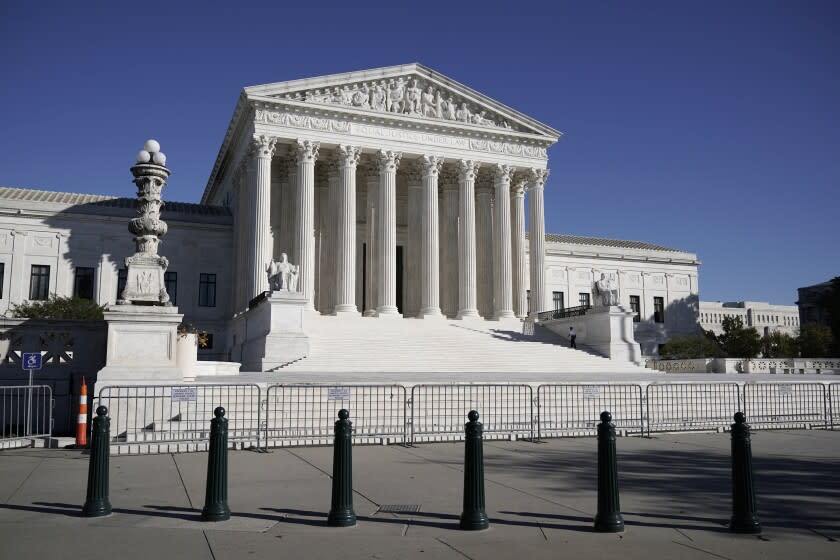Editorial: The Supreme Court tried (sometimes) to not seem like politicians

- Oops!Something went wrong.Please try again later.
- Oops!Something went wrong.Please try again later.
- Oops!Something went wrong.Please try again later.
The Supreme Court term that ended this week offered mixed evidence of whether the justices recognize the importance of acting in a way that combats the corrosive perception that they are partisan “politicians in robes.”
Some important decisions broke down along ideological lines, including a troubling ruling by the court’s conservative majority on Thursday that could make it harder to enforce the Voting Rights Act and a holding that California’s attorney general couldn’t require nonprofits to report the names of their major donors.
Yet in other potentially divisive cases the court demonstrated commendable collegiality, compromise and restraint. And despite predictions that then-President Trump’s three appointees would slavishly protect his interests, Justices Neil M. Gorsuch, Brett M. Kavanaugh and Amy Coney Barrett did not come to Trump’s rescue when frivolous litigation was filed seeking to overturn the election of President Biden.
They also proved capable of making common cause with Democratic appointees in some cases. For instance, Barrett and Kavanaugh joined in a majority opinion by Justice Stephen G. Breyer, a Bill Clinton appointee, rebuffing the latest challenge to the Affordable Care Act. In opposing Barrett’s confirmation, Senate Democrats had warned that she would destroy the ACA, with Sen. Dianne Feinstein contending that “healthcare coverage for millions of Americans is at stake with this nomination.”
Another example: All three Democratic appointees signed Chief Justice John G. Roberts Jr.’s majority opinion holding that the city of Philadelphia violated the 1st Amendment when it canceled its contract with a Catholic agency that wouldn’t consider same-sex couples as prospective foster parents.
Many feared that the court would use this case to create a major loophole in anti-discrimination laws. But Roberts' opinion was reassuringly narrow and fact-specific in its reasoning. It said that the city violated the Catholic agency’s right to the free exercise of religion by not granting it an exception allowed for under the city’s policy.
The justices were unanimous in other important decisions. They included a ruling that the NCAA’s restrictions on educational benefits for college athletes violated antitrust law and a decision making it harder for police to enter a home without a warrant.
Unfortunately, the quest for consensus went only so far. Last month the conservative majority struck down a California labor-law regulation, ruling that agricultural landowners and food processors have a right to keep union organizers off their property. Roberts’ majority opinion implausibly labeled the limited access granted to organizers a “physical taking” under the 5th Amendment.
Then on Thursday, the justices divided in the last two cases they decided this term along both ideological lines and in terms of the party of the presidents who appointed them. The split on the question of donor disclosure for nonprofits is regrettable, but not a substantial threat to the court’s reputation.
But the divide between Republican and Democratic appointees in the voting rights case is distressing. The case involved two restrictions imposed in Arizona: a directive that ballots cast in the wrong precinct be discarded and a ban on third-party collection of mail-in ballots — so-called ballot harvesting.
Writing for the six Republican-appointed justices, Justice Samuel A. Alito Jr. rejected a claim by the Democratic National Committee that Arizona’s rules violated Section 2 of the Voting Rights Act because they “disparately affect Arizona’s American Indian, Hispanic, and African American citizens.”
Compared with other restrictions being pressed in Republican-controlled legislatures, Arizona’s rules may seem like minor burdens on the right to vote. But Alito’s opinion upholding them dramatically limited the protections of Section 2, offering what Justice Elena Kagan in her dissent rightly called “a cramped reading [of] broad language.”
Richard L. Hasen, an election-law expert at UC Irvine, said that although the ruling is “not a death blow for Section 2 claims,” it will make it “much, much harder for such challenges to succeed.” Given the stakes for the country and the court, the justices should have strived to achieve in this case the common ground they staked out to their credit in so many others. Their failure to do so increases the obligation of Congress to step in and protect the right to vote.
For the record:
10:05 a.m. July 5, 2021: This editorial erroneously states that the high court issued its two final opinions of the term Thursday. It issued a per curiam opinion Friday in a case without hearing arguments.
This story originally appeared in Los Angeles Times.

